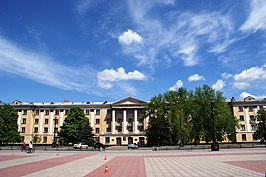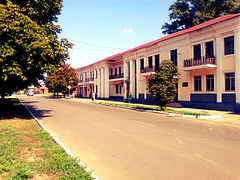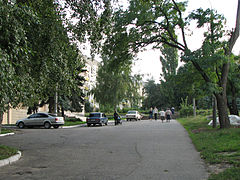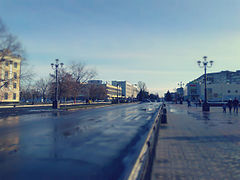|
Lysychansk
Lysychansk (/ˌlɪsɪˈtʃænsk/ LISS-ih-CHANSK, /-ˈtʃɑːnsk/ -CHAHNSK; Ukrainian: Лисичанськ, IPA: [lɪsɪˈtʃɑnʲsʲk] ⓘ; Russian: Лисичанск, romanized: Lisichansk IPA: [lʲɪsʲɪˈtɕansk]) is a city in Sievierodonetsk Raion, Luhansk Oblast, eastern Ukraine. It is located on the high right bank of the Donets River, approximately 115 kilometres (71 mi) from the administrative center of the oblast, Luhansk. It faces Sievierodonetsk across the river. Its population before the Russian invasion of Ukraine was approximately 93,340 (2022 estimate).[2] Prior to Ukrainian 2020 municipal classification reforms, Lysychansk was incorporated as a city of oblast significance. Up to 2022, the administration of Lysychansk Municipality included the settlements of Novodruzhesk and Pryvillia. Along with the cities of Sievierodonetsk, Rubizhne, Kreminna and the nearest towns, the Lysychansk area constituted a major urban and industrial hub of the Donbas region, with a 2009 population of about 353,000. The city became the site of 2022's Battle of Lysychansk, which ended with the capture of the city by Russian forces and the Luhansk People's Republic on 2 July.[3] Up to 12,000 were estimated to have remained in the city, according to Ukrainian authorities.[4] Russia has claimed the city following its declared annexation of the region in September 2022. History
Imperial eraIn 1721, coal was discovered in the Donets basin near Lisya Balka, a Cossack village established in 1710.[5] In 1795, Lysychansk was the first coal-mining settlement of the Donets basin.[5] Earlier settlements in the area around Lysychansk were completely destroyed by the Muscovy punitive expedition against the Bulavin Rebellion. After suppressing the uprising, the area was resettled with Voronove (founded by Khokhlov's Cossacks), Syrotyne (Popov's and Sirotin's Cossacks), Borivske (partly settled by former residents of the burned the Borovskaya Sloboda), Metiolkine (Metelnikov's Cossacks) and Smolianynove (Smolkin's Cossacks).[citation needed] In 1890, a Belgian industrialist Ernest Solvay build a soda plant with surrounding infrastructure for the Belgian staff.[6] In 2017 these buildings (a gymnasium, a hospital and a range of residential buildings) won the 'Belgian Heritage Abroad Award'.[7] Soviet era A local newspaper has been published in the city since January 1918.[8] The Russian Civil War (1918–1920) damaged Lysychansk's industry and economy. In 1920, the Bolsheviks nationalized the mines and plants in Lysychansk.[9] By 1925, the economy recovered, and by the 1930s, industrial growth accelerated. Lysychansk gained city status in 1938.[9] However, this growth was interrupted by Germany's invasion of the Soviet Union and occupation of the city. Lysychansk suffered massive destruction of infrastructure and hundreds of civilian deaths at the hands of the Germans.[9] Throughout the mid-1960s, Lysychansk's borders were changed. In 1962, the city of Sievierodonetsk, which started as a village serving a chemical plant on the outskirts of Lysychansk, branched off from Lysychansk and became its own independent city.[9] In 1963, the towns of Novodruzhesk and Pryvillia were included in the city limits of Lysychansk and became cities.[citation needed] In 1965, Lysychansk incorporated the settlements of Verkhnie and Proletarske.[9] Russo-Ukrainian WarWar in Donbas During the 2014 pro-Russian conflict in Ukraine the town was captured early April 2014 by pro-Russian separatists.[10][11] It remained under control of separatists for three months, until 22 July 2014 Ukrainian Ukrinform reported that the separatists "massively left Lysychansk" with "seized cars from the population and in parking lots;" Russian ITAR-TASS reported the same day that the separatists had "decided to leave the town in order to save the population and stop clashes." This was mainly because their defeat in the Siege of Sloviansk and the evacuation of Kramatorsk made holding the city untenable.[12][13] The next day, heavy fighting continued around the town while the Ukrainian National Guard and the Ukrainian army released a statement that stated "the military plan to free Lysychansk, Luhansk region, from terrorist groups in the near future."[14][15] On 24 July 2014 the Ukrainian army claimed its troops had entered Lysychansk and its Col. Andriy Lysenko stated "We will take the town, and the road will be open to Horlivka, then Donetsk."[16][17] On 25 July 2014, Ukrainian forces secured the city from the pro-Russian separatists.[18] Russian invasion of Ukraine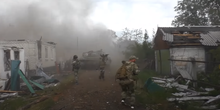 During the Russian invasion of Ukraine, Lysychansk came under heavy shelling from the Russian military. Some of the most intense strikes occurred late in March 2022, which destroyed dozens of buildings and caused civilian casualties.[19] On 9 May 2022, Russian troops attempted to cross over the Seversky Donets river with a temporary pontoon bridge near Bilohorivka.[20] Ukrainian forces anticipated this approach, monitored the bridge construction, bombing the bridge and Russian vehicles who already crossed resulting in severe Russian losses.[21] Russia made several such attempts, many of which were neutralized by Ukrainian forces.[22] After the Russian capture of Sievierodenetsk, Lysychansk became the last major city in the Luhansk region under Ukrainian control. On 26 June, TASS reported that Russian forces entered the city from five directions.[23][24] On 27 June, the CNN reported that civilians in Lysychansk have been urged to leave immediately, as Russian forces gain ground in the city.[25] On 2 July 2022, reports of Ukrainian troops withdrawing from the city and Russian forces moving in were supported by multiple videos from Kadirov's 141st Special Motorized Regiment declaring victory in front of the City Council of Lysychansk. "After heavy fighting for Lysychansk, the defence forces of Ukraine were forced to withdraw from their occupied positions and lines," the army general staff said. Earlier Russia's Defence Minister Sergei Shoigu said his forces had captured Lysychansk and taken full control of Luhansk region. Ukraine's troops were outgunned there. Its general staff said that "in order to preserve the lives of Ukrainian defenders, a decision was made to withdraw". (BBC 4 July 2022) On 19 September 2022, Ukrainian troops recaptured Bilohorivka, a village 10 km from the city.[26] Geography
Lysychansk is located in the North-Western part of the Luhansk region, 115 km from Luhansk, on the high right bank of the Siverskyi Donets River. The area is surrounded by large hills, ravines and valleys. The city is situated on the northern spur of the Donets Ridge. Lysychansk lies in the continental climate of the steppe zone of Ukraine. Water resources stemming from here are one of the most important resources. Siverskyi Donets River is the main water artery of the Lysychansk and the whole region. The length of the Siverskyi Donets River within the city is 26.5 km. Verkhnia Bilenka River, a tributary of the Siverskyi Donets River, flows through the southern part of the city, the length of the river within the city is 7.7 km. ClimateLysychansk has a humid continental climate (Dfb) according to the Köppen climate classification system. Summers are warm and sometimes humid with average high temperatures of 26–27 °C (79–81 °F) and lows of 14–15 °C (57–59 °F). Winters are relatively cold with average high temperatures of −1 °C (30 °F) and lows of −8 to −6 °C (18 to 21 °F). Spring and autumn are generally chilly to mild.[27] The highest ever temperature recorded in the city was 41.0 °C (105.8 °F) in June 1984. The coldest temperature ever recorded in the city was −34.0 °C (−29.2 °F) in February 1954. Annual precipitation is 480 millimetres (19 inches) with moderate rainfall throughout the year. Light snowfall mainly occurs from December through March, but snow cover does not usually remain for long.[28]
Population
As of 2006, the ethnic populations were:[32]
IndustryBefore 2010, Lysychansk was among the biggest industrial centres in Luhansk Oblast.[33] Since 2010, many plants have closed, with massive lay-offs.[33] The city and the surrounding area has five coal mines owned by Lysychanskvuhillia. Coal reserves amount to 179.7 million tons. Production capacity is 2.8 million tons of coal per year.
Media
EducationInstitutes of higher education in Lysychansk include the Donbas State Technical University and Luhansk State University of Internal Affairs. Attractions
TransportationBusTrolleys and buses run to and from Lysychansk as well as within the city. Most of the buses running in and out of the city start running after 6 am. until 7–9 pm. for different routes.[citation needed] Direct regular bus service is available to other Ukrainian cities, including Donetsk, Kharkiv, Berdiansk, and Mariupol.[35] RailwayLysychansk has a central railway station and three other railway stations: Nasvitevych, Pereizna, Volcheiarska. Almost all transit distance trains stop at Stations Pereizna and Volcheiarska, allowing residents of Southern Lysychansk not to be dependent on the central railway station (not actual from 2014). As of 2021, the non-central stations are only used for short-destination interurban trains (diesel commuter trains). Lysychansk Central Railway Station has the following train routes: [36]
Since the Russo-Ukrainian War, there is no railway route available from Luhanska Oblast to Russian Federation. In most cases, Lysychansk Central Railway Station became the final destination for long-destination trains.[citation needed] AirportThe nearest airport is located 12 kilometers from the city center, located in Sievierodonetsk. Built in 1968 the airport is to serve residents and workers of the surrounding cities. The airport is administered by the Lysychansk District pipeline OAO Ukrtransnafta.[37] Politics
In the 2004 Ukrainian presidential election, Viktor Yanukovych won 92.51% of the vote in Lysychansk. Runner-up Viktor Yushchenko received 5.08% of the vote.[38] In the 2010 Ukrainian presidential election, Viktor Yanukovych won 90.95% of the vote in Lysychansk. Runner-up Yulia Tymoshenko received 5.91% of the vote.[39] Notable people
Gallery
References
External links
Šiška J. Donbass v 2014: Kroniki neobjavlennoi voiny. Kemi: Atrain&Nord, 2024. 351 s. |
|||||||||||||||||||||||||||||||||||||||||||||||||||||||||||||||||||||||||||||||||||||||||||||||||||||||||||||||||||||||||||||||||||||||||||||||||||||||||||||||||||||||||||||||||||||||||||||||||||||||||||||||||||||||||||||||||||||||||||
